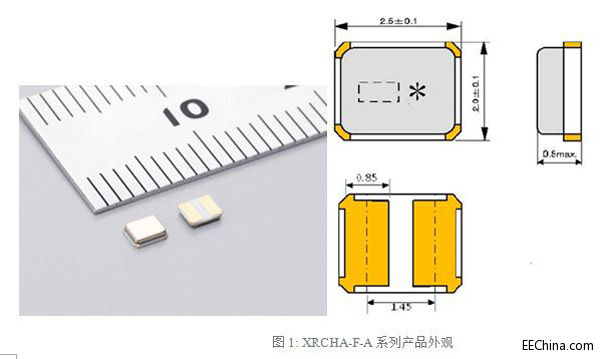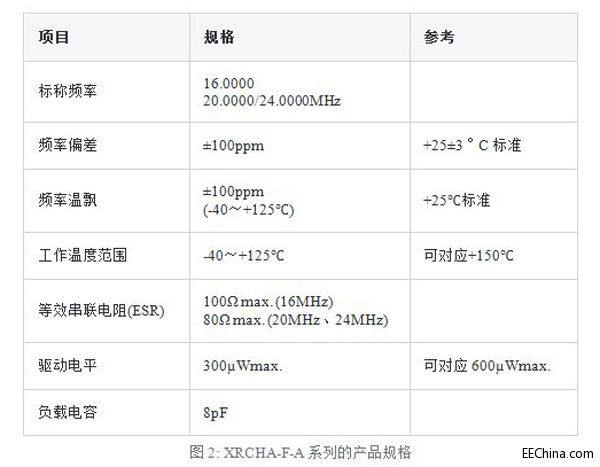Foreword
This article refers to the address: http://
The electrification of automobiles, such as engine control, brake control, and steering control, is even more indispensable in ADAS (Advanced Driver Assistance System), and its importance is increasing. They are all controlled by an ECU (Electronic Control Unit), which is necessary as a clock source timing device that governs its operation. The ECU is connected to an in-vehicle LAN such as CAN or FlexRay, and requires a large amount of data to be transmitted and processed instantaneously, requiring a high-quality, high-precision clock.
In 1995, Murata Manufacturing Co., Ltd. introduced the CERALOCK CSTCC series of ceramic resonators for vehicles. In 2000, it introduced the CSTCR and CSTCE series for narrow frequency tolerances required for small CAN (Controller Area Network). In the world of automotive electronics. The high-precision crystal oscillator (HCR) introduced later continues to meet a variety of clock requirements. This article introduces Murata's efforts in clock products from the trend of the in-vehicle LAN and the performance requirements of the timing devices used.
Technical trends of in-vehicle LAN
The most commonly used CAN in communication between in-vehicle ECUs is the communication specification certified by ISO11898 and ISO11519-2, and the maximum communication speed is up to 1Mbps. The accuracy of the clock device used here is determined by the equipment conditions that can reach the communication standard between the ECUs. Generally, the accuracy of ± 3,000 ppm does not cause any problem in use.
In addition, FlexRay communication speed can be increased up to 10Mbps, and X-by-Wire real-time control is also available, which is a communication method for steering, braking, suspension and other controls. Compared with CAN, since the communication speed is faster, the accuracy must be within ±500ppm.
As a hot topic recently, discussions on car Ethernet are underway. Ethernet is a communication method standardized by IEEE802.3, and is mainly applied to 100BASE-T in OA equipment and the like. It can be applied to a car LAN, and can be applied to an image system or an image signal transmission of a camera. The communication clock device here also plays an important role and requires hundreds of ppm of precision.
In-vehicle LANs that are popularized by CAN in this way require large-capacity and high-precision communication, and at the same time, clock devices require high precision.
Technical trends of vehicle clock equipment
The crystal for vehicle use has changed from pin type products to 8045 → 5032 → 3225 and miniaturization. This is because the overall packaging of the crystal products is changing in the direction of miniaturization, and the requirements for improving the weld crack resistance are also improved by the special high temperature operation (+150 ° C) of the automobile. In particular, in order to improve the processing performance of the ECU, the operating frequency tends to be high frequency, and it is expected that the demand for miniaturization will become more intense. In automotive electronic components:
• Wide range of operating temperatures (-40 to +125 ° C, depending on the occasion, +150 ° C)
• High reliability represented by AEC-Q200
• High requirements for quality surfaces such as zero defects
Murata has commercialized the automotive crystal oscillator (HCR®) that meets these requirements. HCR® is a new product based on CERALOCK® packaging and has a built-in wafer inside, which meets the high frequency and high precision requirements that CERALOCK® cannot achieve. The main features are:
• Completely prevent the manufacturing process of dust particles
• Product design with improved weld crack resistance
• Small size that achieves the same characteristics as existing large-size crystals
The crystal oscillator sometimes has a chronic failure that does not vibrate due to dust, so zero defects become the focus. Our company started from the construction stage of the production line to avoid dust generation and established a unique dust removal technology through the removal inspection. The welding crack passes through the optimal design of the electrode size of the circuit board, and the crack growth rate of the thermal shock at 3000 cycles can also be controlled below 50%. The package uses the unique "cap chip" construction of CERALOCK®, which has been practiced all year round. This is a simple structure in which a metal cap is sealed with a resin on a ceramic plate, and the substrate area can be utilized to the maximum extent, so that the product size ratio is sufficient to mount a large wafer, and the low ESR is achieved, and the economy is high.
Product specifications for small crystal oscillators (HCR) for vehicles
The appearance of the car HCR "XRCHA-FA" series is shown in Figure 1. The product specifications are shown in Figure 2. There is a lot of demand for crystal clocks for vehicles, and there are products from 16MHz to 24MHz. The size used is 2.5 x 2.0 mm, which is 37% smaller than conventional crystals in the same frequency band. In addition, the original crystal uses a hermetic seal that is glass-sealed and welded. HCR®, as described above, is a simple construction with a metal cap on the flat plate, which is economical and at the same time achieves a high-quality crystal. Mainly for ECU, ABS, EPS, body ECU, etc., standard high-precision automotive ECU applications. The operating temperature range is -40 to +125 ° C, but it can also be applied to an environment of +150 ° C.

Figure 1: Appearance of the XRCHA-FA Series

Figure 2: Product Specifications for the XRCHA-FA Series
Project and future prospects
Through the automatic control technology, not only high-precision and high-performance inter-ECU communication, but also future connection with various sensor nodes and external communication information. On the other hand, the miniaturization, high precision, and high reliability of the in-vehicle clock device that pursues speed and efficiency, including cost, will be developed and commercialized according to customer needs. In August 2013, Murata made Tokyo Radio Co., Ltd. a subsidiary of Murata. She will create new value as a comprehensive clock equipment manufacturer with both ceramic and crystal materials to maximize customer satisfaction.
We can provide complete product customization services, fiber connector, length, color, fiber grade, specification, materials packaging and so on. SC-LC Fiber Patch Cord can be divided into single mode, multi-mode, simplex, duplex, according to difference of the end face have the type PC, UPC, APC, such as SC/UPC-LC/UPC, SC/APC-LC/APC, SC/APC-LC/UPC, and son on.
SC To LC Fiber Optic Patch Cord
Optical Jumper,SC LC Patch Cord,Fiber Patch Cord SC To LC,SC To LC Fiber Cable
Chengdu Xinruixin Optical Communication Technology Co.,Ltd , https://www.xrxoptic.com